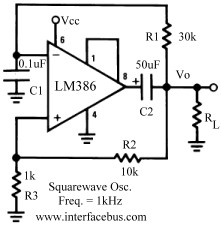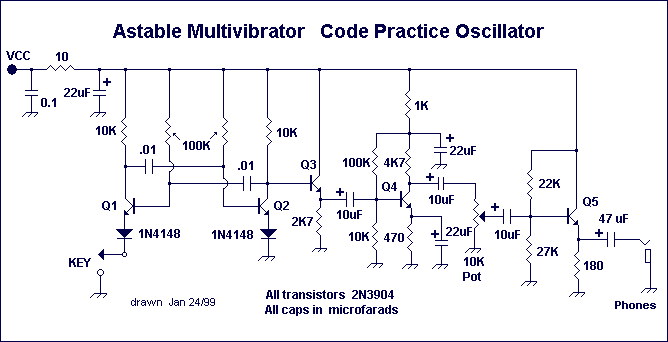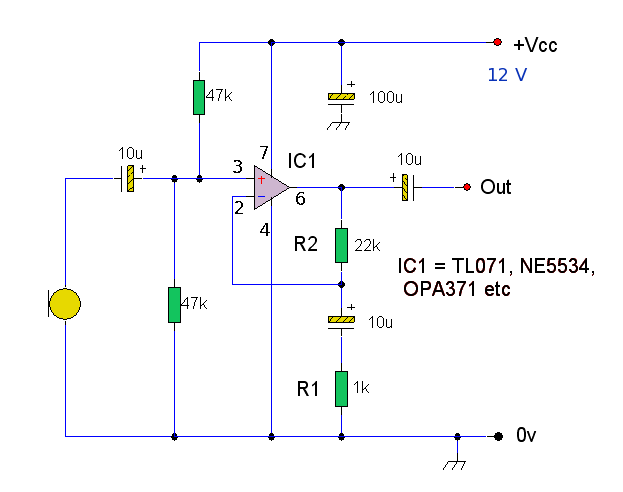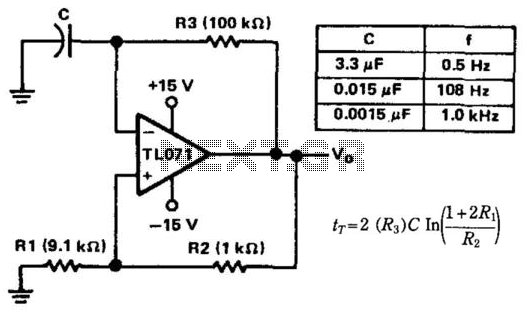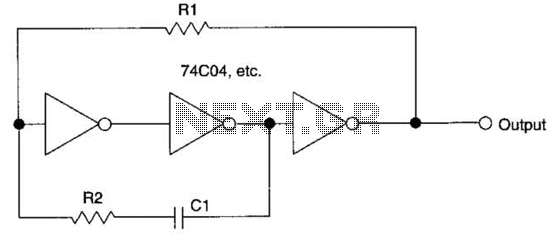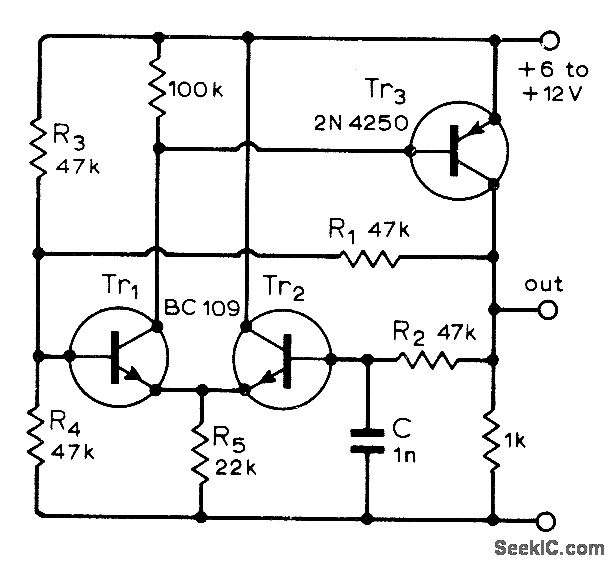
OP-AMP or comparator Astable multivibrator

Simulation schematic for an astable multivibrator. Parameters: Vcc = 24V, Vol = 1V, Voh = 21V. The power supply is Vcc, with connections from Vcc to ground. The time constant is determined by R1 and the capacitor C1, where R1 is 1kΩ and C1 is 100nF. The integrated circuit (IC) has a voltage at Vc of 0V. Reference resistors include R2 (100kΩ), R3 (100kΩ), and R4 (100kΩ), with connections from Vo to Vr and from Vr to ground. A comparator (E1) is used with the input voltage levels defined in the table: (-1mV, Vol), (-1μV, Vol), (1μV, Voh), and (1mV, Voh). The transient analysis is set to 500μs.
The astable multivibrator is a fundamental circuit used for generating square waves and is characterized by its lack of a stable state, continuously switching between high and low outputs. In this schematic, the power supply voltage (Vcc) is set to 24V, which powers the entire circuit. The output voltage low (Vol) is defined as 1V, while the output voltage high (Voh) is set at 21V, indicating the swing of the output signal.
The time constant of the circuit is influenced by the resistor R1, valued at 1kΩ, and the capacitor C1, which has a capacitance of 100nF. The time constant (τ) can be calculated using the formula τ = R1 * C1, which determines the charging and discharging cycles of the capacitor, thereby affecting the frequency of oscillation.
The resistors R2, R3, and R4, all valued at 100kΩ, are used to set the reference voltages and feedback within the circuit. These resistors help establish the thresholds for the comparator (E1), which compares the voltage levels at its inputs and drives the output high or low based on the comparison. The voltage levels for the comparator's operation are defined in a lookup table, indicating specific input-output relationships.
Transient analysis is configured to run for 500μs, allowing observation of the waveform generated by the astable multivibrator over time. This analysis provides insight into the timing characteristics and stability of the generated square wave, essential for applications requiring precise timing signals. Overall, this simulation schematic serves as a comprehensive guide for constructing an astable multivibrator circuit, demonstrating key parameters and operational principles.Simulation schematic for astable multivibrator Parameters Vcc=24 Vol=1 Voh=21 Power supply Vcc Vcc 0 {Vcc} Time constant R1 Vo Vc 1K C1 Vc 0 100n. IC V(Vc)=0 * *Reference R2 Vo Vr 100K R3 Vcc Vr 100K R4 Vr 0 100K * *Comparator E1 Vo 0 Vr Vc table=(-1m {Vol} -1u {Vol} 1u {Voh} 1m {Voh}) *.
TRAN 500u. END 🔗 External reference
The astable multivibrator is a fundamental circuit used for generating square waves and is characterized by its lack of a stable state, continuously switching between high and low outputs. In this schematic, the power supply voltage (Vcc) is set to 24V, which powers the entire circuit. The output voltage low (Vol) is defined as 1V, while the output voltage high (Voh) is set at 21V, indicating the swing of the output signal.
The time constant of the circuit is influenced by the resistor R1, valued at 1kΩ, and the capacitor C1, which has a capacitance of 100nF. The time constant (τ) can be calculated using the formula τ = R1 * C1, which determines the charging and discharging cycles of the capacitor, thereby affecting the frequency of oscillation.
The resistors R2, R3, and R4, all valued at 100kΩ, are used to set the reference voltages and feedback within the circuit. These resistors help establish the thresholds for the comparator (E1), which compares the voltage levels at its inputs and drives the output high or low based on the comparison. The voltage levels for the comparator's operation are defined in a lookup table, indicating specific input-output relationships.
Transient analysis is configured to run for 500μs, allowing observation of the waveform generated by the astable multivibrator over time. This analysis provides insight into the timing characteristics and stability of the generated square wave, essential for applications requiring precise timing signals. Overall, this simulation schematic serves as a comprehensive guide for constructing an astable multivibrator circuit, demonstrating key parameters and operational principles.Simulation schematic for astable multivibrator Parameters Vcc=24 Vol=1 Voh=21 Power supply Vcc Vcc 0 {Vcc} Time constant R1 Vo Vc 1K C1 Vc 0 100n. IC V(Vc)=0 * *Reference R2 Vo Vr 100K R3 Vcc Vr 100K R4 Vr 0 100K * *Comparator E1 Vo 0 Vr Vc table=(-1m {Vol} -1u {Vol} 1u {Voh} 1m {Voh}) *.
TRAN 500u. END 🔗 External reference
